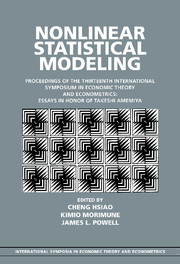 Nonlinear Statistical Modeling
Nonlinear Statistical Modeling Book contents
- Frontmatter
- Contents
- Series editor's introduction
- Editors' introduction
- Contributors
- 1 Local instrumental variables
- 2 Empirically relevant power comparisons for limited-dependent-variable models
- 3 Simulation estimation of polychotomous-choice sample selection models
- 4 A new approach to the attrition problem in longitudinal studies
- 5 Semiparametric estimation for left-censored duration models
- 6 Semiparametric estimation of censored selection models
- 7 Studentization in Edgeworth expansions for estimates of semiparametric index models
- 8 Nonparametric identification under response-based sampling
- 9 On selecting regression variables to maximize their significance
- 10 Using information on the moments of disturbances to increase the efficiency of estimation
- 11 Minimal conditions for weak convergence of the sample standardized spectral distribution function
- 12 Unit root tests for time series with a structural break when the break point is known
- 13 Power comparisons of the discontinuous trend unit root tests
- 14 On the simultaneous switching autoregressive model
- 15 Some econometrics of scarring
- 16 A censored switching regression approach to evaluating the effect of sunk costs and firm-level disequilibrium on export performance
- Curriculum vitae of Takeshi Amemiya
- Index
12 - Unit root tests for time series with a structural break when the break point is known
Published online by Cambridge University Press: 05 June 2012
- Frontmatter
- Contents
- Series editor's introduction
- Editors' introduction
- Contributors
- 1 Local instrumental variables
- 2 Empirically relevant power comparisons for limited-dependent-variable models
- 3 Simulation estimation of polychotomous-choice sample selection models
- 4 A new approach to the attrition problem in longitudinal studies
- 5 Semiparametric estimation for left-censored duration models
- 6 Semiparametric estimation of censored selection models
- 7 Studentization in Edgeworth expansions for estimates of semiparametric index models
- 8 Nonparametric identification under response-based sampling
- 9 On selecting regression variables to maximize their significance
- 10 Using information on the moments of disturbances to increase the efficiency of estimation
- 11 Minimal conditions for weak convergence of the sample standardized spectral distribution function
- 12 Unit root tests for time series with a structural break when the break point is known
- 13 Power comparisons of the discontinuous trend unit root tests
- 14 On the simultaneous switching autoregressive model
- 15 Some econometrics of scarring
- 16 A censored switching regression approach to evaluating the effect of sunk costs and firm-level disequilibrium on export performance
- Curriculum vitae of Takeshi Amemiya
- Index
Summary
Introduction
A number of studies consider testing for unit roots in univariate time series which have a level shift. Examples are Perron (1989, 1990), Perron and Vogelsang (1992), Banerjee, Lumsdaine, and Stock (1992), Zivot and Andrews (1992), Amsler and Lee (1995), Leybourne, Newbold, and Vougas (1998), Montanes and Reyes (1998), and Saikkonen and Lütkepohl (1999). These tests are important because the trending properties of a set of time series determine to some extent which model and statistical procedures are suitable for analyzing their relationship. In the aforementioned studies different models and assumptions for the structural shift are considered. In some of the studies the timing of the break point is assumed to be known, whereas in others a shift in an unknown period is considered. There seems to be general consensus, however, that if the break point is known, this is useful information which should be taken into account in the subsequent analysis and in particular in testing for unit roots. Therefore we will focus on the latter case in the following. In practice, a known break point is quite common. For instance, many German macroeconomic time series are known to have a shift in 1990 where the German reunification took place.
For the case of a known break point we will propose a framework which generalizes previously considered models. In this framework the shift is modeled as part of the intercept term of the stationary part of the data generation process (DGP) which is clearly separated from the unit root part.
- Type
- Chapter
- Information
- Nonlinear Statistical ModelingProceedings of the Thirteenth International Symposium in Economic Theory and Econometrics: Essays in Honor of Takeshi Amemiya, pp. 327 - 348Publisher: Cambridge University PressPrint publication year: 2001
- 4
- Cited by
